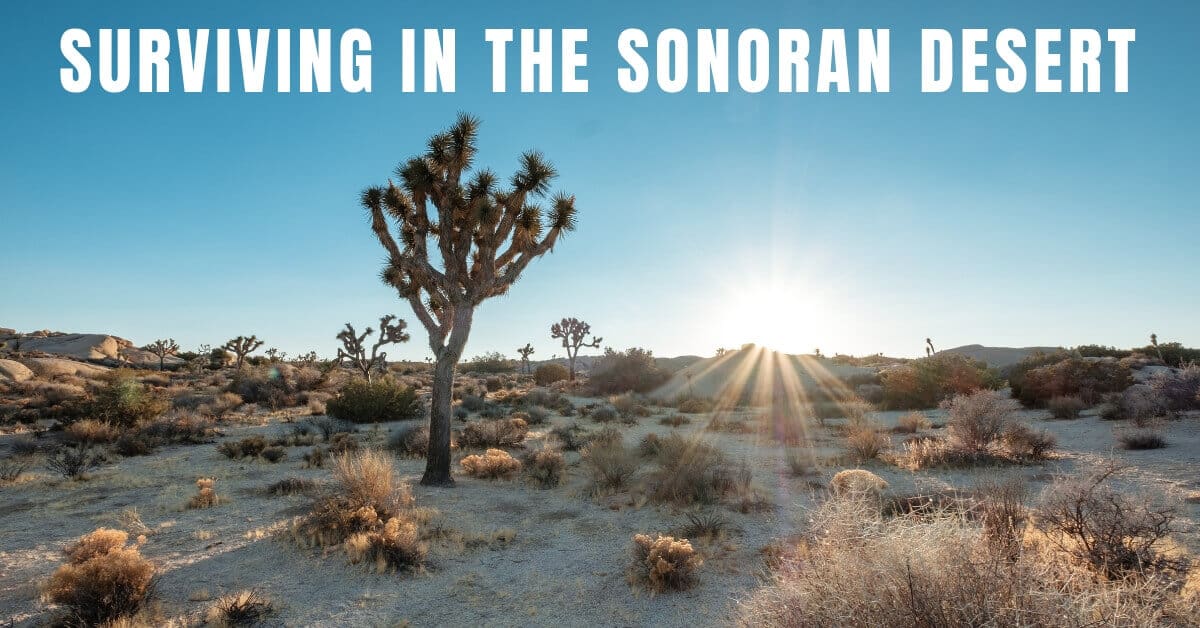- Finding the Right Indoor Plants for Desert Your Home - April 28, 2023
- Common Misunderstanding About Sun Exposure - April 18, 2023
- All about the Arizona Monsoon Season - May 21, 2021
Any desert dweller will tell you: our landscape is one of awe-inspiring beauty, but the desert extremes can also be astoundingly cruel. The Sonoran Desert has the dubious honor of being home to the United States’ hottest place and covers some of the most arid land in the United States. Add to the heat and lack of water severe drops in night time temperatures and a shortage of forage-able food and the desert can quickly turn deadly.
Go Prepared
Any time you plan to be in a desert climate you should be prepared. In your car always carry at least three gallons of water at all times. Having a brightly colored blanket for warmth and signaling is also a good idea. If you are traveling light, a reflective mylar blanket can help you survive. Carry one in your backpack when hiking, especially in unfamiliar territory.
You can’t count on cellular service in many areas of the desert, but a spare portable battery pack or solar recharger can help make sure your phone has a charge when you can use it. Carry a compass and manual multitool. A GPS device is incredibly handy, but a paper map of the area you are travelling is good too. Travel with a supply of lightweight, nutrient-dense foods like power bars. An LED flashlight or headlamp can be indispensable in a tight situation.
Don’t Leave Your Car
If your vehicle breaks down in the desert, don’t leave it – especially to head out on an unknown route. Prop open your hood to signal for help and find nearby shade. If no shade is available, try to rest in the shadow of your car or scoop a shallow trench nearby where you can rest and take advantage of the cooler temperatures just a little bit below the desert’s surface.
Keep drinking water and eat your available food at regular intervals. Salty snacks will help you retain water. If help has not arrived by nightfall, sleep in your vehicle. A vehicle is the easiest way to find people reported missing, and in most cases is the biggest thing you have to signal your location and need for help.
Lost on Foot
Getting lost while on foot can be much trickier. If you find yourself lost in the desert you’ll need to conserve energy and keep yourself hydrated. Don’t travel in the heat of the sun. During daylight build a signal that can be noticed from the air, such as the word “HELP” spelled large in stones that contrast against the color of the surrounding earth.
Lay low in the daytime – stay in the shade and take note of your surroundings. Keep drinking water and eat at regular intervals. If you have a GPS device or can get cell phone service, send a distress signal and wait for rescue. Consult your map if you have one and try to trace the course you took. Look for nearby landmarks to figure out your current position and plan your next moves accordingly.
If you don’t have a map, try to remember notable landmarks you observed while walking. Keep in mind, if you choose to try and retrace your steps these landmarks may look different when you come from the opposite direction. During daylight rest, hydrate and plan your route back to safety. As the sun sets, be prepared for night to be much chillier, and cautiously begin to move in the direction you came from.
With the orientation of where west is (where the sun sets) hike as much as you can while you can orient yourself by the dwindling light. If possible follow the route you came from. Your footprints may still be visible in the earth and can lead you back to safety. Once the sun has set fully, travel more cautiously. If you become confused, do not keep hiking. Instead, wait until daybreak and hike when you can orient yourself to the sun’s position, stopping when the heat becomes oppressive.
Finding Food and Water
Sources of food and water are elusive in the desert. Most parts of beavertail cactus are edible and will provide you with water (and a few thorns, most likely). Barrel cactuses also have edible flesh in an emergency. Mesquite trees have edible pods and junipers produce small edible berries. Agave plants can also be foraged and eaten. The desert is a fragile ecosystem, so foraging food from native plants is only encouraged in the event of an emergency.
CC Sunscreens
You wouldn’t go out into the Sonoran Desert unprepared, so why would you let your home go without CC Sunscreens? Sunscreens protect your home from the sun and keep temperatures cool and comfortable without astronomical energy bills. Live in the desert the smart way – give CC Sunscreens a call.

